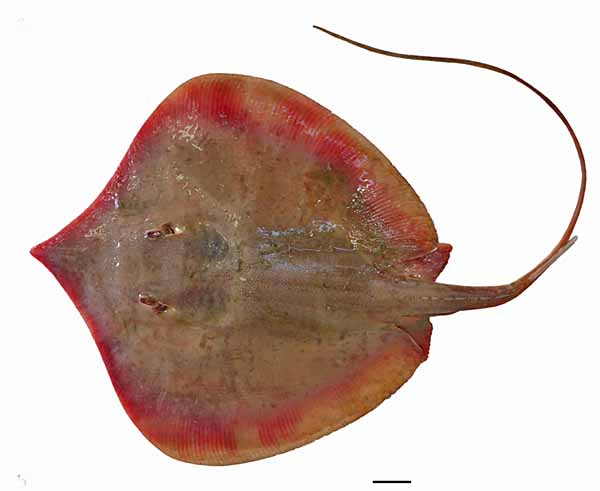Brevitrygon walga
(Müller & Henle, 1841)
|
Familie: Dasyatidae SynonymeTrygon walga Müller & Henle, 1841
Lokale BezeichnungBengalischer Peitschenrochen - Bengal Whipray - Scaly Whipray |
 Brevitrygon walga (CSIRO H 8667-01, adultes ♂, Myanmar) -- (C) P. Psomadakis, 2023 in: Diversity, 15 (12): 1213. |
Typen
Lectotypus: MNHN 2431.
Siehe: Eschmeyer, W.N., Fricke, R. & Van der Laan, R. (eds.) 2024. Catalog of Fishes electronic version
Typusfundort: Golf von Bengalen, Ganges-Delta, Indien [Rotes Meer; Ganges-Delta].
Etymologie
Vermutlich eine abweichende Schreibweise von wolga, von Wolga Tenkée, einem lokalen Namen für diesen oder einen verwandten Stechrochen aus dem Gangesdelta in Indien.
Verbreitung
Golf von Bengalen, Madras (Ostindien) bis östlich von Bok Ye-gan (Myanmar). Berichtet aus Bangladesch, wo fir Art vermutlich ins Süßwasser vordringt.
IUCN Status

EX Extinct (ausgestorben)
EW Extinct in the Wild (in der Natur ausgestorben)
CR Critically Endangered (vom Aussterben bedroht)EN Endangered (stark gefährdet)
VU Vulnerable (gefährdet)
NT Near Threatened (potenziell gefährdet)
LC Least Concern (nicht gefährdet)
RE Regionally Extinct (regional oder national ausgestorben)DD Data Deficient (ungenügende Datengrundlage)
NE Not Evaluated (nicht beurteilt)
Status: Stand 5.3.2024: NE Not Evaluated (nicht beurteilt)
Gefahren für diese Art: (nicht beurteilt)
Literatur
- Müller, J.P. & Henle, F.G.J. 1838–41. Systematische Beschreibung der Plagiostomen. Veit und Comp., Berlin. i–xxii + 1–200, 60 pls. BHL Zitatseite [:Lectotypus MNHN 2431, !!, als Trygon walga]
- Bleeker, P. 1852. Bijdrage tot de kennis der Plagiostomen van den Indischen Archipel. Verhandelingen van het Bataviaasch Genootschap van Kunsten en Wetenschappen, 24 (12): 1-92, Pls. 1-4. Zitatseite [:67 (Beschreibung). Fundorte: Batavia (=Java), Samarang (=Semarang), Indonesien (wahrscheinlich eine Verwechslung), als Trygon walga]
- Günther, A. 1870. Catalogue of the fishes in the British Museum. Catalogue of the Physostomi, containing the families Gymnotidae, Symbranchidae, Muraenidae, Pegasidae, and of the Lophobranchii, Plectognathi, Dipnoi, ...[thru] ... Leptocardii, in the British Museum. 8: i-xxv + 1-549. (BHL) Zitatseite [:475 (Kurzbeschreibung). Fundort: Ostindien (wahrscheinlich eine Verwechslung mit Brevitrygon heterura), als Trygon (Himantura) walga]
- Boeseman, M. 1983. Atlas Ichthyologique des Indes Orientales Néêrlandaises, par M. P. Bleeker. In: Reproduction for the First Time of Plates Originally Prepared for Unpublished Tomes XI–XIV; Smithsonian Institution Press: Washington, DC, USA. Zitatseite [, pl. 563 Figs 1a,b (Plagiostom. Pl. 41) (Abbildung eines männlichen Syntypus von Brevitrygon heterura), als Leiobatis (Himantura) walga]
- Séret, B. & McEachran, J.D. 1987. Catalogue critique des types de Poissons du Muséum national d’Histoire naturelle. (Suite) Poissons Batoïdes (Chondrichthyes, Elasmobranchii, Batoidea). Bulletin du Museum National d'Histoire Naturelle, Série 4: Section A: Zoologie, Biologie et Écologie Animales, 8 (4, suppl.) [1986]: 3–50. Zitatseite [:20 (Fehlidentifikation), als Himantura imbricata]
- Krishnan, S. & Mishra, S.S. 1993. On a collection of fish from Kakinada-Gopalpur sector of the east coast of India. Records of the Zoological Survey of India, 93 (1–2): 201–240, 1 pl. Zitatseite [:211, Misidentifikation, Dasyatis walga --> Brevitrygon manjajiae]
- Last, P.R. & Compagno, L.J.V. 1999. Mehrere Familienberichte über Rochen. In:
- Carpenter, K.E. & Niem. V.H. 1999. FAO species identification guide for fishery purposes. The living marine resources of the Western Central Pacific. Vol. 3. Batoid fishes, chimaeras and bony fishes part 1 (Elopidae to Linophrynidae). Rome, FAO, Rome. Zitatseite Zitatseite [:1492, z.T. Fehlidentifikation, Himantura walga --> Brevitrygon manjajiae]
- White, W.T., Last, P.R., Stevens, J.D., Yearsley, G.K., Fahmi & Dharmadi 2006. Economically Important Sharks and Rays of Indonesia. ACIAR Monograph, Series No 124: 1–329. Zitatseite [:260, figs Himantura cf. walga --> Brevitrygon javaensis]
- Weigmann, S. 2011. Contribution to the taxonomy and distribution of eight ray species (Chondrichthyes, Batoidea) from coastal waters of Thailand. Verhandlungen des Naturwissenschftlichen Vereins in Hamburg, Neue Folge, 46: 249–312. Zitatseite [:265–272, 299–302, Himantura walga --> Brevitrygon heterura]
- Last, P.R., Naylor, G.J.P. & Manjaji-Matsumoto, B.M. 2016. A revised classification of the family Dasyatidae (Chondrichthyes: Myliobatiformes) based on new morphological and molecular insights. Zootaxa, 4139 (3): 345-368. Zitatseite [:360, z.T. Misidentification, Brevitrygon walga --> Brevitrygon manjajiae]
- Golzarianpour, K., Malek, M., Golestaninasab, M., Sarafrazi, A., Kochmann, J. & Klimpel, S. 2020. Insights into the Urogymnid whiprays (Chondrichthyes: Batoidea) in the Persian Gulf and the Gulf of Oman, with an amendment of their diagnostic characteristics and dispersal range. Zootaxa, 4819 (2): 316–334. (doi) Zitatseite [:332, Fig 1 (Fehlidentifikation), als Brevitrygon imbricata]
- Last, P.R., Weigmann, S. & Naylor, G.J.P. 2023. The Indo-Pacific Stingray Genus Brevitrygon (Myliobatiformes: Dasyatidae): Clarification of Historical Names and Description of a New Species, B. manjajiae sp. nov., from the Western Indian Ocean. Diversity, 15 (12): 1213. (doi) Zitatseite [:26, Figs 2–6, 12, 13, 16–22, & 39, Lectotypus festgelegt, Farbfoto, Beschreibung, Verbreitung, Genetik]